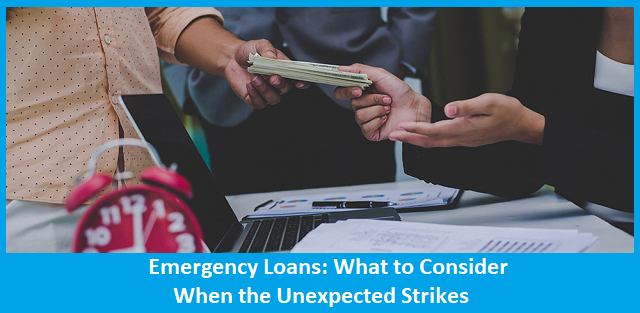Emergencies often catch us off guard, leaving individuals and families grappling with sudden financial burdens they may not be equipped to handle. Whether it’s an unforeseen medical expense, car repair, or home repair, having access to emergency funds can offer crucial relief during times of crisis. However, building a substantial emergency fund isn’t always feasible for everyone, leading many to seek alternative solutions to cover urgent expenses. In such scenarios, emergency loans can serve as a lifeline to bridge the gap and ease financial strain. In this guide, we’ll delve into what emergency loans entail, when to consider them, and how to navigate the process responsibly.

Understanding Emergency Loans:
Emergency loans, also referred to as crisis loans or short-term loans, are small-dollar loans crafted to provide swift access to funds for unforeseen expenses. Typically unsecured, meaning they don’t require collateral, these loans are meant to be repaid within a short timeframe, often spanning from a few weeks to months. Offered by banks, credit unions, online lenders, or alternative financial institutions, each provider presents its own terms, prerequisites, and interest rates.
When to Consider Emergency Loans:
Though emergency loans offer immediate relief during critical situations, it’s crucial to assess whether they’re the right fit for your financial circumstances. Here are some scenarios where emergency loans might be worth considering:
- Urgent Expenses: When faced with expenses that cannot be postponed, such as medical bills, car repairs, home repairs, or unexpected travel costs, emergency loans can provide the necessary funds to address the situation promptly.
- Lack of Savings: If you lack an adequate emergency fund to cover unforeseen expenses, emergency loans can act as a temporary solution until you’re able to replenish your savings. While building an emergency fund should be a priority, these loans offer a safety net in the absence of sufficient savings.
- No Alternative Funding Sources: After exhausting other funding options like borrowing from friends or family, using credit cards, or tapping into a home equity line of credit, emergency loans may offer a viable alternative to meet immediate financial needs. Despite typically higher interest rates, they may be more accessible and convenient in certain circumstances.
- Preserving Financial Stability: Taking out an emergency loan can sometimes prevent further financial hardship and safeguard your overall financial stability. By addressing urgent expenses promptly, you can sidestep late fees, penalties, or other adverse consequences that could worsen your financial situation over time.
Navigating Emergency Loans Responsibly:
While emergency loans provide much-needed relief, it’s essential to approach them with caution to avoid falling into a debt cycle. Here are some tips for responsible navigation:
- Assess Your Financial Situation: Before applying for an emergency loan, evaluate your financial standing and ability to repay. Consider factors like income, expenses, existing debt, and available resources to determine if taking on additional debt is sustainable in the long run.
- Borrow Only What You Need: Resist the urge to borrow more than necessary. When applying for an emergency loan, borrow only what’s required to cover immediate expenses. Borrowing excessively can lead to higher interest costs and increased financial strain.
- Compare Lenders and Options: Shop around and compare offers from various lenders to find the most competitive rates, terms, and fees for your emergency loan. Consider factors like interest rates, repayment terms, loan amounts, and eligibility requirements to secure the best deal.
- Read the Fine Print: Thoroughly review the terms and conditions of the loan agreement before signing. Pay close attention to the APR, which reflects the total cost of borrowing, including interest and fees. Ensure you understand all terms and obligations outlined in the agreement.
- Develop a Repayment Plan: Establish a realistic repayment plan for your emergency loan to ensure timely payments and avoid defaulting. Factor loan payments into your budget and prioritize them accordingly to prevent late fees or penalties.
- Explore Alternatives: Before opting for an emergency loan, explore alternative funding sources such as negotiating payment plans with creditors or seeking assistance from local charities or government programs. Exhaust all available resources to minimize financial impact.
Conclusion:
Emergency loans can be a lifeline during times of crisis, offering immediate relief for unexpected expenses. However, it’s vital to approach them with care and responsibility to avoid worsening your financial situation. By assessing your needs, borrowing wisely, comparing options, reading the fine print, planning repayment, and exploring alternatives, you can navigate emergency loans effectively and mitigate their financial impact. Remember, building an emergency fund over time remains the best defense against unforeseen expenses, safeguarding your financial stability in the long run.
